MEC-00: Fundamental of Experimental Uncertainty (Error) and Data Analysis
- Explain the details of uncertainty (error) and data analysis
- Modul: Download Here
MEC-01: Measuring Length
The caliper gauge, micrometer screw and spherometer are precision measuring instruments; their use is practiced in practical measuring exercises.
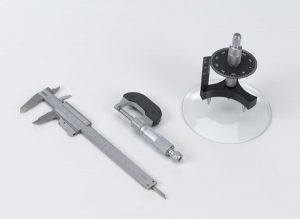
Experiments:
| MEC-01-01 | Vernier Calliper | |||||
| MEC-01-02 | Micrometer Screw | |||||
| MEC-01-03 | Spherometer | |||||
MEC-02: Static Effects of Forces
Forces can be recognized by their effects. Thus, static forces can e.g. deform a body. It becomes apparent that the deformation is proportional to the force acting on the body when this force is not too great.
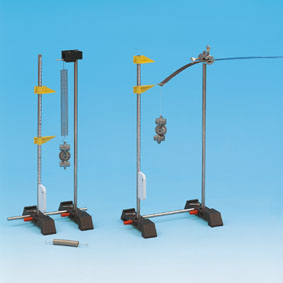
Experiments:
| MEC-02-01 | Expansion of a helical spring | |||||
| MEC-02-02 | Bending of a leaf spring | |||||
MEC-03: One Dimensional motion on Fletcher’s trolley
Fletcher’s trolley is the classical experiment apparatus for investigating linear translational motions. The trolley has a ball bearing, his axles are spring-mounted and completely immerged in order to prevent being overloaded. The wheels are designed in such a way that the trolley centers itself on the track and friction at the wheel flanks is avoided.
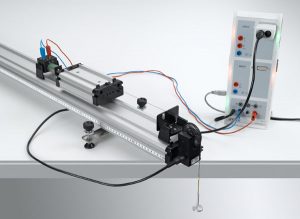
Experiments:
MEC 03
MEC-04: Two-dimensional motions on the air table
The air table makes possible recording of any two-dimensional motions of a slider for evaluation following the experiment. To achieve this, the slider is equipped with a recording device which registers the position of the slider on metallized recording paper every 20 ms.
The air table is supplied complete with two sliders. This means that this apparatus can also be used to investigate e.g. two –dimensional collisions.
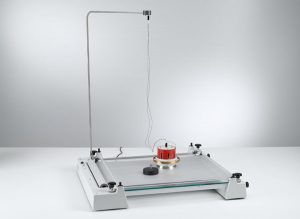
Experiments:
| MEC-04-01 | Uniform linear motion and uniform circular motion (P1.3.7.1) | |||||
| MEC-04-02 | Uniformly accelerated motion (P1.3.7.2) | |||||
| MEC-04-03 | Two-dimensional motion on an inclined plane | |||||
| MEC-04-04 | Two-dimensional motion in response to a central force | |||||
| MEC-04-05 | Superposing translational and rotational motion on a rigid body | |||||
| MEC-04-06 | Two-dimensional motion of two elastically coupled bodies | |||||
| MEC-04-07 | Experimentally verifying the equality of a force and its opposing force | |||||
| MEC-04-08 | Elastic collision in two dimensions | |||||
| MEC-04-09 | Inelastic collision in two dimensions | |||||
MEC-05: Rotational Motions
The low-friction Plexiglas disk of the rotation model is set in uniform or uniformly accelerated motion for quantitative investigations of rotational motions. Forked light barriers are used to determine the angular velocity; their light beams are interrupted by a 10° flag mounted on the rotating disk. When two forked light barriers are used, measurement of time t can be started and stopped for any angle φ (optional possible).
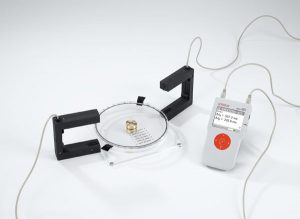
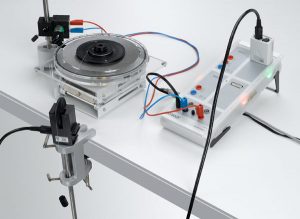
Experiments:
| MEC-05-01 | Path-time diagrams of rotational motions – Recording and evaluating with CASSY (P1.4.1.2 ) | |||||
| MEC-05-02 | Conservation of angular momentum (P1.4.2 ) | |||||
| MEC-05-03 | Conservation of angular momentum in elastic rotational collision (P1.4.2.1) | |||||
| MEC-05-04 | Conservation of angular momentum in inelastic rotational collision (P1.4.2.2 ) | |||||
MEC-06: Oscillations
The torsion pendulum after Pohl can be used to investigate free or forced harmonic rotational oscillations. An electromagnetic eddy current brake damps these oscillations to a greater or lesser extent, depending on the set current. The torsion pendulum is excited to forced oscillations by means of a motor-driven eccentric rod.
The computer-assisted CASSY measured-value recording system is ideal for recording and evaluating the oscillations of the torsion pendulum. The numerous evaluation options enable a comprehensive comparison between theory and experiment. Thus, for example, the recorded data can be displayed as path-time, velocity-time and acceleration-time diagrams or as a phase diagram (path-velocity diagram).
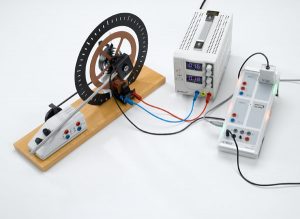
Experiments:
| MEC-06-01 | Free rotational oscillations – Recording with CASSY (physics lab 2017) | |||||
| MEC-06-02 | Forced harmonic and chaotic rotational oscillations – Recording with CASSY | |||||
MEC-07: Wave Mechanics
A wave is formed when two coupled, oscillating systems sequentially execute oscillations of the same type. The wave can be excited e.g. as a transversal wave on an elastic string or as a longitudinal wave along a helical spring.
Experiments:
| MEC-07-01 | Standing transversal waves on a thread (physics lab 2017) | |||||
| MEC-07-02 | Standing longitudinal waves on a helical spring (P1.6.1.2 ) | |||||
MEC-08: Aero and Hydrodynamics
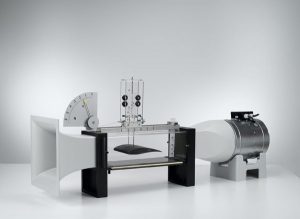
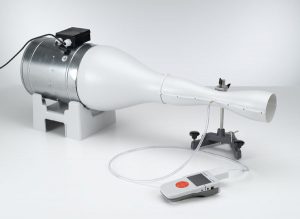
Experiments:
| MEC-08-01 | Static pressure in a reduced cross-section – Measuring the pressure with a pressure sensor and CASSY | |||||
| MEC-08-02 | Recording the airfoil profile polars in a wind tunnel (P1.8.7.1. ) (For physics lab AVE 2017) | |||||
| MEC-08-03 | Measuring students’ own airfoils and panels in the wind tunnel (P1.8.7.2. ) | |||||
| MEC-08-04 | Verifying the Bernoulli equation – Measuring with the precision manometer | |||||
| MEC-08-05 | Verifying the Bernoulli equation – Measuring with a pressure sensor and CASSY | |||||
Oscilloscope
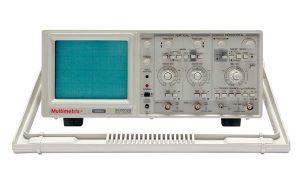
Analog Oscilloscope
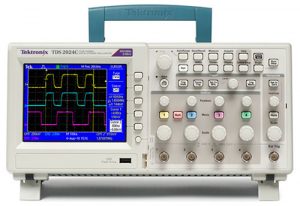
| OSC-01 | Theory of Oscilloscope |
| OSC-02 | Introduction to Digital Oscilloscope |
Low Pass Filter
Video:
[embedyt] https://www.youtube.com/watch?v=m4GqFwP6r7w[/embedyt]
